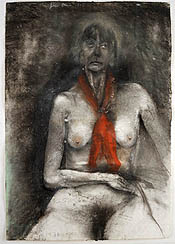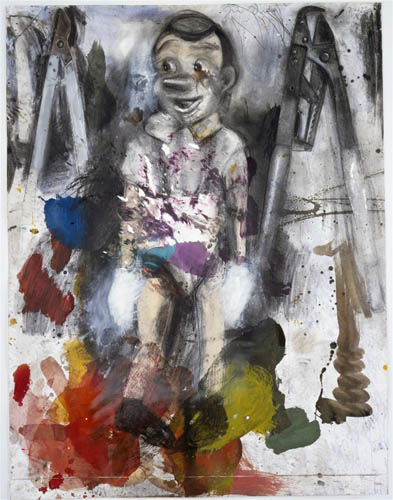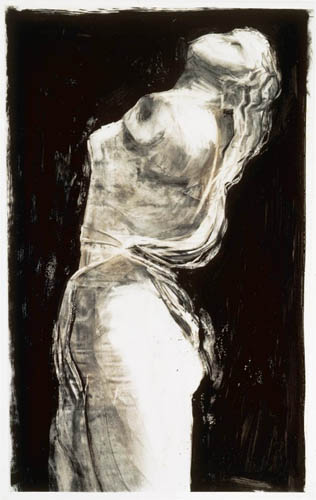Leading American artist Jim Dine's groundbreaking achievements as a draftsman beginning around 1970 were featured in Drawings of Jim Dine at the National Gallery of Art, West Building, March 21 through August 1, 2004. The first major survey of Dine's drawings in over 15 years, the exhibition included more than 100 of his drawings from around 1970 to the present, borrowed from public and private collections. Often associated with Pop art and the Happenings of the 1960s, Dine became known for his paintings, prints, and sculptures--works that employed recurring themes such as tools, hearts, and bathrobes. This exhibition will focus on subjects for which Dine is renowned--his iconic images of tools--as well as less publicized themes from the eighties and nineties, including images of owls, studies of ancient sculpture and nature, and portrayals of proverbial characters such as Pinocchio.

Drawings of Jim Dine was organized chronologically and began with a 16-foot-long charcoal work on canvas entitled Name Painting (1935-1963) #1 from 1968-1969. National Gallery curator Judith Brodie suggested that this work--an attempt by Dine to recall all the names of those individuals who affected his life between 1935 and 1963--very likely inspired a period of concentrated involvement with drawing during the 1970s. Works on view from that decade showcased Dine's intensified commitment to drawing and include a series of seven superb drawings of tools from the Museum of Modern Art, New York.

In 1974, Dine began drawing from the figure, employing live models, photographs, mirror-images of himself, even department store mannequins. The Die-Maker (1975) reveals Dine's shift to life drawing and his innate skills as a draftsman.

Other large-scale and evocative drawings of nudes--The Skier (1976),
The Red Glove (1975–1976)

and Red Scarf (1976)--reveal a similar attention to the human form as well as Dine's very physical approach to drawing. Some areas of these drawings are abraded and torn. Dine aims to have his works convey a sense of history, the weathered signs of their own making. In Nine Self-Portraits with a Very Long Beard (1977), Dine explored the traditional genre of self-portraiture but in a non-traditional format, creating a set of nine variably adjusted drawings that the artist considers one work.
Since the last major exhibition of his drawings in 1988, Dine has introduced new subjects--such as antique sculpture, the owl and raven, a towering mountain in Austria, and the puppet Pinocchio. Dine feels a strong kinship with all of his subjects. In the case of Pinocchio, he adopts the puppet as an alter ego. He is moved by the puppet's tale, especially his genesis and identifies with Geppetto's ability to bring an inanimate object to life.

Pinocchio with Two Kinds of Clippers from 2002 pairs the new subject of Pinocchio with the artist's trademark tools, enriching Dine's dialogue with his subjects.
Throughout the seventies and into the eighties, Dine lived in Vermont and in this lush environment, trees, plants and flowers became one of his enduring themes, as revealed in Tree (The Kimono) from 1980 and Mandrake Root (after Ligozzi) from 1985.

In keeping with the artist's inclination to revisit chosen themes, the exhibition also featured drawings of tools from 2000 to the present, such as Elyria,
Natural Light #1, and Natural Light #2.

The exhibition concluded with one room devoted entirely to forty works--The Glyptotek Drawings--made from early Greek and Roman sculpture. These forty separate sheets, which constitute one work, demonstrate Dine's profound sense of wonder in the presence of the antique.
THE ARTIST
Dine was born in 1935 in Cincinnati, Ohio. After his mother's death when he was a teenager, he went to live with his maternal grandparents. His grandfather owned a hardware store where Dine acquired an appreciation for tools. Dine received a B.F.A. in 1957 from Ohio University and enrolled in its graduate program the following year. In 1958 he went to New York, where he collaborated with artists such as Claes Oldenburg. Dine soon became a pioneer creator of Happenings--multimedia theatrical pieces that were highly unpredictable in character.
Dine's mixed-media constructions and experimentation with Happenings quickly earned him a reputation as an exceptional young talent, and between 1960 and 1965 his work was widely exhibited with that of the newly emerging Pop artists. In the 1970s Dine made a dramatic shift, an aspect of which was a heightened regard for drawing. He believed that he had exhausted the possibilities at hand and needed a broader foundation to build on--one grounded in life drawing. Dine's objective was not, however, to become a figurative artist, instead, as he states in the exhibition catalogue, it was "all about looking--looking hard."
As Dine continued to revise his artistic ambitions throughout the 1970s, he repeatedly turned to drawing. Thirty years later, drawing remains at the core of his range of expression.

Judith Brodie, curator of modern prints and drawings at the National Gallery of Art, was curator of the exhibition and principal author of the catalogue (200 pages, 110 color plates). The artist joined the design team of the catalogue, which was co-published by the National Gallery of Art and Gerhard Steidl, Göttingen.
Related article